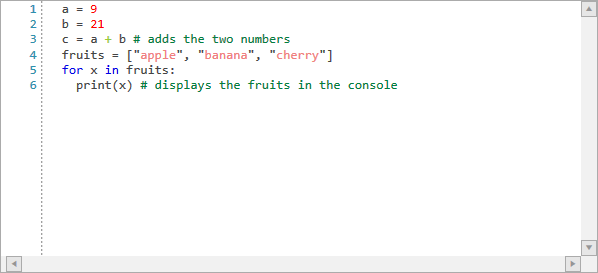Custom Language
By using the WordTaggerBase as a base, you can create custom syntax highlighting for any custom language. In this article we will create basic highlighting for the Python programming language.
Let's define the following class which will be responsible for classifying the words of the opened document.
Example 1: The custom tagger
public class PythonTagger : WordTaggerBase
{
private static readonly string[] Keywords = new string[]
{
"False", "None", "True", "and", "as", "assert","break", "class",
"continue", "def", "del", "elif", "else", "except", "for", "from",
"global", "if", "import", "in", "is", "lambda", "nonlocal", "not",
"or", "pass", "raise", "finally", "return", "try", "while", "with", "yield"
};
private static readonly string[] Comments = new string[]
{
"#"
};
private static readonly string[] Operators = new string[]
{
"+", "-", "*", "/"
};
public static readonly ClassificationType FruitsClassificationType = new ClassificationType("Fruits");
private static readonly string[] Fruits = new string[]
{
"apple", "banana", "blue_berry", "cherry"
};
private static readonly Dictionary<string, ClassificationType> WordsToClassificationType = new Dictionary<string, ClassificationType>();
static PythonTagger()
{
WordsToClassificationType = new Dictionary<string, ClassificationType>();
foreach (var keyword in Keywords)
{
WordsToClassificationType.Add(keyword, ClassificationTypes.Keyword);
}
foreach (var preprocessor in Operators)
{
WordsToClassificationType.Add(preprocessor, ClassificationTypes.Operator);
}
foreach (var comment in Comments)
{
WordsToClassificationType.Add(comment, ClassificationTypes.Comment);
}
foreach (var comment in Fruits)
{
WordsToClassificationType.Add(comment, FruitsClassificationType);
}
}
public PythonTagger(Telerik.Windows.Controls.RadSyntaxEditor editor)
: base(editor)
{
}
protected override Dictionary<string, ClassificationType> GetWordsToClassificationTypes()
{
return PythonTagger.WordsToClassificationType;
}
protected override bool TryGetClassificationType(string word, out ClassificationType classificationType)
{
int number;
if (int.TryParse(word, out number))
{
classificationType = ClassificationTypes.NumberLiteral;
return true;
}
return base.TryGetClassificationType(word, out classificationType);
}
protected override void OnWordSplit(int wordCharType, string word)
{
if (wordCharType == 3 && word.Length > 1)
{
this.AddWord(word, ClassificationTypes.Comment);
}
}
protected override int GetCharType(char c)
{
if (c == '#')
{
return 3;
}
if (c == '_')
{
return 0;
}
if (char.IsWhiteSpace(c))
{
return 1;
}
if (char.IsPunctuation(c) || char.IsSymbol(c))
{
return 2;
}
return 0;
}
}
Keyword, Comment, Operator or the custom Fruits classification type.
In addition, in the TryGetClassificationType method override we assign the NumberLiteral classification type to any word that can be parsed to an integer.
We also override the OnWordSplit method to ensure that comments are highlighted correctly even if multiple comment (#) symbols are placed one next to the other.
Lastly, we override the GetCharType method to correctly highlight blue_berry as by default it will be split by the underscore (_) character and not be matched as a classification type.
We can then register the custom tagger in RadSyntaxEditor's TaggersRegistry just as we would with any other tagger. We also add custom TextFormatDefinitions with specific foregrounds for the NumberLiteral, Operator and the custom FruitsClassificationType which we created earlier.
Example 2: Registering the custom tagger
var pythonTagger = new PythonTagger(this.syntaxEditor);
if (!this.syntaxEditor.TaggersRegistry.IsTaggerRegistered(pythonTagger))
{
this.syntaxEditor.TaggersRegistry.RegisterTagger(pythonTagger);
}
this.syntaxEditor.TextFormatDefinitions.AddLast(ClassificationTypes.NumberLiteral, new TextFormatDefinition(new SolidColorBrush(Colors.Red)));
this.syntaxEditor.TextFormatDefinitions.AddLast(ClassificationTypes.Operator, new TextFormatDefinition(new SolidColorBrush(Colors.YellowGreen)));
this.syntaxEditor.TextFormatDefinitions.AddLast(PythonTagger.FruitsClassificationType, new TextFormatDefinition(new SolidColorBrush(Colors.LightCoral)));
Figure 1: The custom Python tagger
